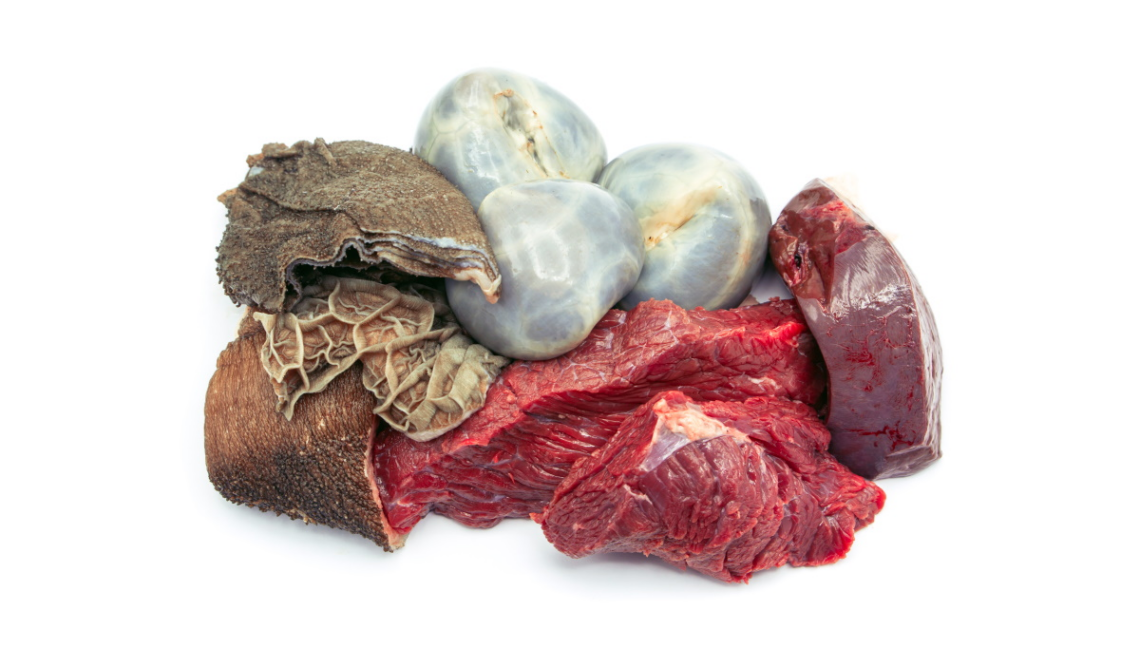Biologically, Species Appropriate, Real and Raw Food for Cats and Dogs
Real and raw food diets for cats and dogs are based on whole foods, which means that they contain all parts of the animal or plant. This means no processed foods, no refined sugar or flour, no artificial ingredients, no preservatives, no additives, no GMOs, no pesticides, no hormones, no antibiotics, no growth hormones, no steroids, no gluten, no soy, no corn, no wheat, no yeast, no MSG, no hydrogenated oils, no trans fats, no high fructose corn syrup, no artificial sweeteners, no artificial colors, no artificial flavors, no chemical preservatives, no artificial anything.
Whether feeding young dogs or cats, puppies or kittens, or senior citizens, real biologically species appropriate real and raw food, food for our cats and dogs must include both muscle and organ meat. Muscle meat is the flesh located between the skin and bones of an animal. Organ meat includes the internal organs of the prey animal. You should feed more muscle meat than organ meat, and meat for most dogs and cats can have a high fat content, proportionately of course. This is due to their first energy system leveraging fat as the energy source. Frequent inclusion of a small portion of raw or par coooked heart is good, especially for cats. Whether or not a wild carnivore eats the organs and stomach contents of a prey animal depends on personal preference and pack status, according to many experts. Even though organ meat is rich in nutrients, too much can upset nutritional balance and cause a loose stool. Feed it in smaller amounts than the muscle meat.
You may also add whole raw eggs to the meat portion of your cat or dogs’ food a few times each week. Do not feed raw salmon unless it has tested free of salmon poisoning. Although some pet parents successfully feed raw pork, many animals find it difficult to digest. Feeding muscle meat in chunk form is best, but unfortunately this allows pets to shake off, or eat around, other important dietary ingredients. By feeding muscle meat in ground or minced form, such as the meals we offer, you will be able to thoroughly mix the other ingredients into the meal. Always feed meat that is fit for human consumption – the exception being raw unprocessed tripe.
Real meat, fish, and eggs provide the following species-appropriate array of nutrients – all in a form with high bioavailability:- amino acids and protein; enzymes; antioxidants; vitamins A, C, D, E, K, B1, B2, B3, B5, B6, and B12; biotin; choline; folic acid; inositol; iodine; pantothenic acid; PABA; fatty acids; calcium; phosphorus; magnesium; iron; potassium; chromium; copper; manganese; selenium; sodium; sulfur; vanadium; zinc and coenzyme Q10.
Muscle meat is high in phosphorus, and low in calcium, hence we promote the inclusion of raw meaty bones in the diet. Not only do raw meaty bones offer a great nutrient profile, but they also supply good upper body and intestinal exercise. And, along with a proper body pH encouraged by eating raw food, they help keep teeth clean. Raw meaty bones provide nutritious marrow, amino acids / protein, essential fatty acids, fiber, enzymes, antioxidants, and a vast array of species-appropriate minerals and vitamins all in a usable form. Plus, they make pets happy!
What are the differences between PREY and BARF?
BARF
The most basic raw and real fooding option is that based on what is commonly known as the BARF diet – for those unfamiliar with this peculiar acronym, it stands for either “Bones and Raw Food Diet”, or “Biologically Appropriate Raw Diet”, or “Biologically Appropriate Real Diet”, depending on whom you ask. Although the idea of fooding dogs anything other than kibble was not a new idea at the time, the book published by Dr Billinghurst in 1993 called Give Your Dog a Bone certainly gave impetus to the idea of fooding as Mother Nature intended. It went back to basics and looked at fooding dogs what they were effectively designed to eat. According to Dr Billinghurst research, dogs are carnivores, vegetarians, scavengers, hunters and opportunists – so a diet of real and raw, meat, bones and offal was the ideal food for our companion canines, as this is what they would naturally eat in the wild – despite the fact that dogs have been domesticated for thousands of years.
In nature, many hunting animals tend to eat virtually all of their kill, including fur, and some stomach contents. This whole carcass method of feeding is not for the squeamish, or those who live in an apartment, but biologically and physiologically dogs have not changed a great deal over time, and are not sufficiently dissimilar to their present wild cousins so as to require a different diet just because they live in our homes rather than in the natural world around us. Some people however struggle to source the food suggested by Dr Billinghurst (his book favors pig carcasses and kangaroos!).
Those who food their dogs and cats parts from a number of different animal sources will maintain that these supply all necessary proteins, minerals and vitamins, as well as promoting healthy teeth, gums, joints and digestion, and many thousands of dog owners still revere Give Your Dog a Bone as the bible for raw feeding.
Since the original publication of Give Your Dog a Bone, however, Dr Billinghurst has slightly revised his feeding model to include 20% crushed vegetable matter and fruit. It is the original absence of these additions which historically set the next method of fooding apart from the BARF diet.
PREY
Another major advocate of the raw and real food diet, Dr Tom Lonsdale, in his book Raw Meaty Bones bases his diet on just those three words – raw, meaty, bones. Whilst not opposed to dogs eating fruit and vegetables, most of the people who follow this diet will agree that the benefits of digesting fruit and vegetables can be obtained from other sources, and recommend fooding a whole prey diet – which would include tripe and smaller animals containing pre-digested vegetable matter. Contrary to popular belief, Dr Lonsdale suggested diet contains up to a maximum of one third vegetation – much higher than the revised recommendation by Dr Billinghurst. The differences between these two feeding camps is therefore tiny, and often only exists in the minds of the supporters of each author.
The diet of wolves in the wild is regularly cited as an example to be followed by both those who feed BARF or raw meaty bones, and yet Dr David Mech (see: Wikipedia) (a recognized expert on wolves) has been quoted as saying wolves in fact are not strict carnivores, but carnivores that also eat omnivore foods, further blurring the definitions.
We believe that for a longer or shorter time, the species “dog” has been living in its own ecological niche and has become adapted to that niche. No matter what it started out as, and no matter when it stopped being a whatever else it was, the species “dog” is now a dog as far as we are concerned, a carnivores that can also eat omnivore foods.
The Supplemented BARF Diet
The third example of a raw and real food diet is similar to a BARF or raw meaty bones diet but with added extras, such as supplements like coconut oil or turmeric. Dr Lonsdale does not recommend supplements, but Dr Billinghurst believes they are sometimes required. These days many raw and rea food feeders believe that the addition of these extras to the diet can only be beneficial to our mutts, pups and nobles after all, we all want our pets to live long and healthy lives, thriving instead of just surviving, so why not food them other foods with known health benefits?
This subject, perhaps more than any other, is one which is argued about the most passionately on almost every raw feeding internet and social media site. People fall in to either of two camps – those that do add extras which can include vegetables and fruit that the animal may not normally eat in the wild, and those who do not – and each will argue the merits of their case until the internet explodes. Those against the addition of vegetables, for example, will argue that the dog does not nutritionally require anything other than meat, bones and offal (as fed by the BARF people) in order to thrive, and would not eat these if left to its own devices.
The arguments raised are usually based on the belief that dogs are strict carnivores, not vegetarians or even omnivores, and therefore have no need of the nutrients and vitamins found in fruit and veg; but as seen above, even the experts are unable to fully agree. The other side, those who do add carrots, kale, sweet potato and a wide range of other whole food ingredients to their dogs diet, will argue that these are all excellent sources of additional nutrients and vitamins, with known heath boosting properties, so why would one not feed them to ones’ dog, even if the dog would not normally eat them in the wild?
What about my feline kids?
For our cat lovers, or rather slaves, another model is currently gaining ground. This model is called the Frankenprey model, which is another variance of BARF and PMR. The Frankenprey model describes the process of creating a whole raw prey animal by using bones, meat, and organs from a variety of animals – like Frankenstein. In the wild, cats eat small birds, rodents, snakes, rabbits, etc. This creates a perfect meal where organs, bones, and muscle meats are in complete proportion. For those of us unwilling to hunt birds and mice for our carnivores (yet still desire to be raw feeders), we turn to Frankenprey.
The Frankenprey model follows a framework that define the ingredients as strict 80 / 10 / 5 / 5 guideline and most raw feeders will follow that over a week’s worth of meals instead of a day’s worth of meals. You’ll see this average weekly intake is more convenient and carries a smaller risk of contamination and vitamin / mineral overload; raw parts are thawed in bulk and fed as soon as possible. There must exist a balance; maybe not a perfect daily balance, but a balance nonetheless. 80% of weekly meals should contain muscle meat, 10% of weekly meals should be made of bones, 5% of weekly meals should be made of liver, and 5% of weekly meals should contain secreting organs like kidneys. This sums up to 100%.
As in any topic, there are proponents of the various methods who eschew all others as being inferior. Do not let these well-meaning but sometimes overly-passionate folks intimidate or discourage you – all three fooding methods (and any combination there-of) are healthy, nutritious and far, far better for your cat than even the best commercially manufactured foods.
Which should you feed, BARF, PMR or Frankenprey?
There honestly is no right or wrong answer, it is just a matter of opinion. The main point most would agree is that you are doing right by fooding your fur kids raw and real food rather than McKibble and McCan. So why does raw and real food matter – and what is it about this subject that inspires such passion in its advocates – be they prey feeders, the raw meaty bones brigade or the BARFers?
Despite the philosophical differences, the different factions will generally stand together against the one issue upon which they all agree – our dogs and cats should not be fed dried processed foods. That is not to say there are no quality dried foods available – but most will agree, where ever possible these should not be fed when a raw and real food diet is a viable alternative.
Try out both and see what works best for you and your dog or cat, or a combination thereof, as we advocate. Personally, as we stated above, we like to feed a mixture of both, more closely aligned with the Supplemented BARF philosophy for dogs and Frankenprey for cats. BARF wins on the convenience factor, however Prey also has its benefits, which is why believe the middle road, a combination of both, is the golden road …
Why freeze the food?
Firstly, frozen food does not need any kind of preservative in order to keep it fresh. This means that there is no need to preserve the food in jelly or biscuit form: you can food your fur kids high-quality, fresh meat tailored to their nutritional needs. Frozen raw food also can contain plenty of natural meat juices and blood. While this may make some people squeamish, for our canine family members, it is a delicious treat. It is also one of the ways dogs in the wild would stay hydrated, so your fur kids will not need to gulp down litres of water every day.
As we stated above, our frozen meals are not cooked like most standard dog foods. Incorrectly cooking food removes a large amount of its nutrients, and alters the levels of others. This makes it blander and less healthy than frozen real raw pet cuisine, which is raw and so contains all the nutritional goodness of fresh meat in the wild. Hence we offer a unique par cooked solution as well.
Finally, working with frozen food is easier for you as the pet parent, guardian and / or slave. This is especially true if you are fooding your fur kids in accordance with biologically species appropriate food diets. Rather than planning out meals full of fresh meat, you can just food your fur kids a portion of frozen dog food. All you need to do is defrost or thaw it, and your dog’s or cat’s dinner is ready to eat, paw-licious!
What Does the Typical Raw and Real Food Diet for Cats and Dogs Consist of?
The typical diet is 60% base product, either chicken wings, beef, chicken breasts, turkey, game, rabbit, duck or ostrich, typically 10% organ meat (which may or may not include liver), 25% vegetables and 5% fruit. These ingredients are minced together and then small amounts of fresh herbs added depending on the manufacturer. The fruits and vegetables are a variety of suitable, fresh and in-season mix which provides important fiber, vitamins and trace elements.
Why do Vets Say Raw and Real Food Diets for Cats and Dogs are not Balanced?
In our opinion, this myth has been perpetuated by McKibble and McCan to discourage pet parents from fooding real food. It is true that just feeding a juicy steak wont provide all the nutrients needed to thrive, but this is not what we provide and advocate. Fooding real food requires a variety of proteins and meals to provide all the vitamins and minerals needed for optimum nutrition. Meals can also be formulated using real food to meet the minimum requirements defined through the National Research Councils (NRC) nutritional profiles for canine and feline all life stages. There are no nutrients in processed food that your dog (or cat) cannot get from natural, whole foods. What is more, the additives and fillers in commercial pet feed offer little nutritional benefit to your pet and are often used as a means of bulking feed out. This means that your dog may be filling up on feed that it not as nutritionally abundant as natural, raw foods.
Why is there is no Scientific Research to Validate Raw and Real Food Diets for Cats and Dogs?
In our opinion, this myth has been perpetuated by McKibble and McCan to discourage pet parents from fooding real food. It is true that few research projects involve real food. However, the no scientific research declaration is a standard cop-out claim that has been used to “debunk” raw diets and in the process economise the truth regarding commercial pet food and associated industry. But one must realise that there is no evidence, whatsoever, to prove that kibble or processed foods are good for your fur kids as well! So, let us make sure you are comfortable with this concept – no long-term research has been done to determine the long-term effects of feeding kibble, nor to determine if it is actually healthy for your dog, as the norm is to just assume it is healthy because it has passed a 6 month feeding trial, after which manufacturers will advertise their product as healthy, nor to determine if raw diets is better or worse than kibble, and so the list continues. Read the Raw Feeding Veterinary Societies position statement, WSAVA Problem 1: The Lack of Documentary Evidence of the Health Benefits of RMBDs (Article).
As the world changes, and information changes, new ideas are born and raised. Some individuals manage to move forward with the new information, and some not. Keep in mind that research can be fallible, research is sometimes biased, and research has come up with as many truths as there are researchers. We just need to be cognizant of our dietary and nutritional guidelines in the last century.
Research, by its very nature, should change as new information becomes available, and “stale” research is often used as the only measure or “stick of truth”, conveniently ignoring ideas that does not fit the “stale” paradigm of reference.
Are All Vets Opposed to Raw and Real Food Diets for Cats and Dogs?
A veterinarian may be wary of raw fooding because of:
- lack of information, or;
- a negative experience with the diet which includes:
treating pets who are malnourished because of an unbalanced raw diet.
–
However, there are many vets who feel positively about real food and seek to educate pet parents, guardians and slaves.
Globally, Dr. Karen Becker, Dr. Cathy Alinovi, Dr Judy Morgan, Dr. Patrick Mahaney, Dr Conor Brady, Dr. Nick Thompson and Dr. Peter Dobias to name but a few.
Many forward thinking vets also subscribe to the Raw Feeding Veterinary Society (RFVS), even more are joining the College of Integrative Veterinary Therapies (CIVT).
Additional Articles and Videos
Good reference articles and videos further reading available at:
- Why Organ Meat is Important for the Raw Fed Dog, by Dana Scott – (DNM);
- Dr. Conor Brady, How to make a raw diet for dogs, Dogfirst (Blog);
- Dr. Conor Brady, A comprehensive review of the pros and cons of feeding dogs vegetables, and best advice, Dogfirst (Blog);
- Dr. Becker – Real Food for Healthy Dogs & Cats, by Beth Taylor and Karen Shaw Becker, DVM (Amazon);
- Dr. Pitcairn – New Complete Guide to Natural Health for Dogs and Cats, by Dr. Richard Pitcairn, DVM, PhD (Amazon);
- Raw & Natural Nutrition for Dogs, by Lew Olson, PhD (Amazon).





